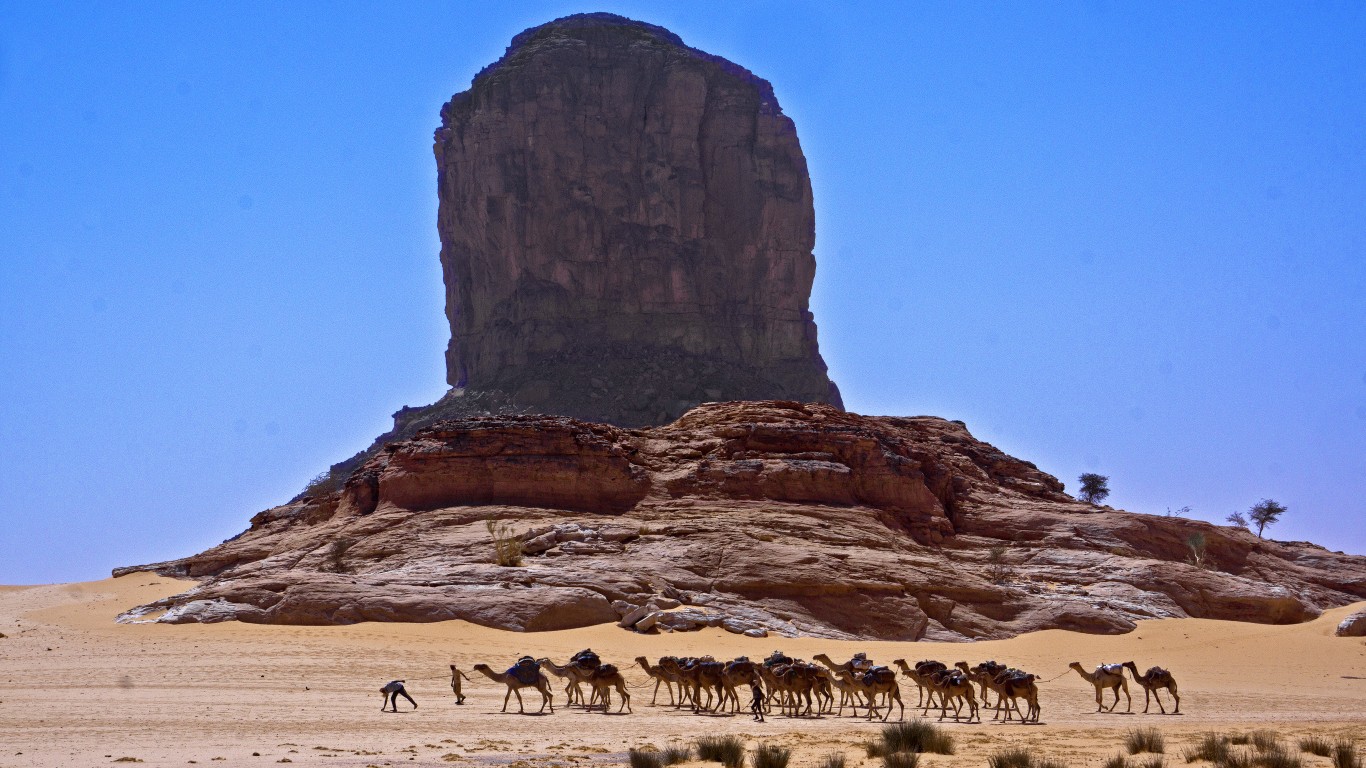
Across the globe, more than 700 million people live less than $1.90 a day — the poverty threshold set by the World Bank. Such severe privation is disproportionately concentrated in certain parts of the world.
Gross national income, or GNI, represents the sum of money earned by a nation’s people and businesses within a given year. Unlike GDP, GNI also measures income earned by corporations based in a given country but operating outside of its borders. GNI per capita is a useful measure for assessing the wealth of a country’s population.
Global GNI per capita — all the income earned worldwide in 2019 — was $17,591. This figure is representative of the pre-tax income the average person earns and is indicative of average quality of life. In dozens of countries, GNI per capita is a fraction of the global average.
Using data from the World Bank, 24/7 Wall St. reviewed the GNI per capita of the 194 nations and special regions with available data to identify the 25 poorest countries. GNI per capita figures for the most recent available year are calculated using purchasing power parity and are in current international dollars. Though some of these countries are in North America and Asia, the vast majority of the world’s poorest countries are in Africa.
While each of the countries on this list is facing different challenges that impede economic development, often stemming from years of struggles, these countries also often share many common elements. Many of these countries have been plagued by political instability and civil war in recent years and have limited or unreliable infrastructure. Though many of them are rich in valuable natural resources, like gold and oil, these assets often fuel internal conflict. These are the countries that control the world’s gold.
Trust in public institutions is also critical for drawing investment and economic development. However, according to a report by the nonprofit corruption watchdog Transparency International, government corruption is rampant in many of these countries. Here is a list of the most corrupt countries in the world.
Low incomes and widespread poverty in these countries has a devastating effect on public health. With relatively limited access to housing, education, nutrition, and health care — all factors that tend to improve health outcomes — life expectancy in these countries is low. With only one exception, life expectancy at birth in every country on this list is at least 3.9 years shy of the global average of 72.6 years.
Click here to see the 25 poorest countries in the world
Click here to see our detailed findings and methodology

25. Zimbabwe
> GNI per capita: $2,730
> 2019 GDP: $21.4 billion (113th out of 206 countries)
> Population (2019): 14.6 million
> Life expectancy at birth in 2018: 61.2 years
Zimbabwe is a country of 14.6 million in southern Africa. Formerly a part of Rhodesia, a colonial British territory, Zimbabwe gained independence in 1980 and has struggled economically since. Severe droughts have hamstrung the country’s agriculture industry, and poor infrastructure and government corruption have discouraged foregin investors and hampered development.
Only about 41% of Zimbabwe’s mostly rural population has access to electricity. The country also struggles with high rates of HIV and tuberculosis. Partially as a result, life expectancy at birth is only 61.2 years, over a decade below the global average.
[in-text-ad]

24. Tanzania
> GNI per capita: $2,700
> 2019 GDP: $63.2 billion (77th out of 206 countries)
> Population (2019): 58.0 million
> Life expectancy at birth in 2018: 65.0 years
The East African nation of Tanzania has a $63.2 billion economy and a population of 58 million. Home to international destinations such as Mount Kilimanjaro, the Serengeti, and the Ngorongoro Crater, Tanzania’s economy depends largely on tourism. Agriculture is also a significant component of the economy, accounting for 28.7% of the country’s GDP.
Despite Tanzania’s strong tourism industry, which many other countries on this list lack, the country’s GNI per capita is only $2,700. The country also has a relatively high income inequality, with nearly half the population living on the equivalent $1.90 per day. Obstacles to development include a lack of reliable infrastructure. Currently, only about a third of the population has access to electricity.

23. Guinea
> GNI per capita: $2,520
> 2019 GDP: $13.6 billion (133rd out of 206 countries)
> Population (2019): 12.8 million
> Life expectancy at birth in 2018: 61.2 years
Guinea, a country on the western coast of Africa, is one of the poorest in the world. Its GNI per capita is just $2,520, about one-seventh of the worldwide GNI per capita of $17,591. More than a third of the population lives on less than $1.90 per day.
Poverty is associated with poor health outcomes. In Guinea, the infant mortality rate of 64.9 per 1,000 births is more than double the worldwide rate of 28.9 per 1,000. The life expectancy at birth is just 61.2 years, over a decade below the worldwide average life expectancy.
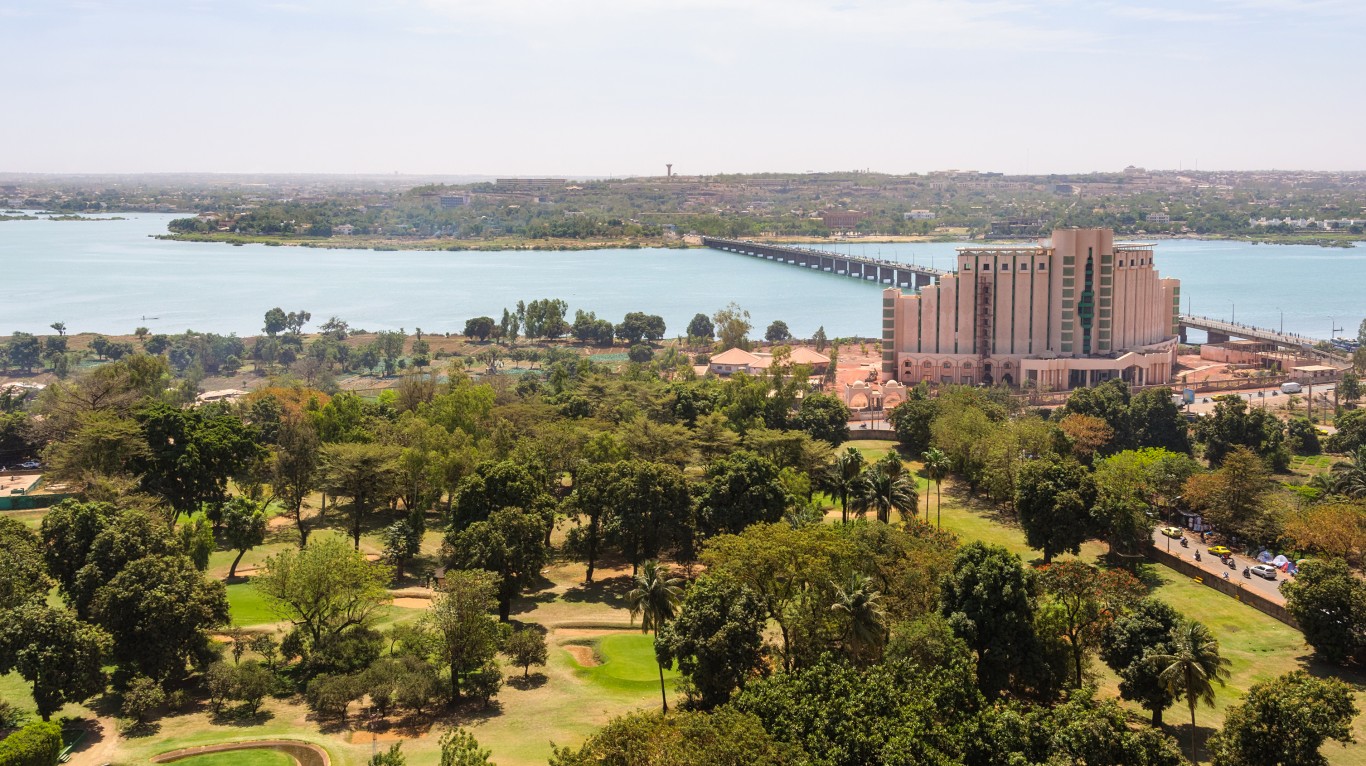
22. Mali
> GNI per capita: $2,360
> 2019 GDP: $17.5 billion (120th out of 206 countries)
> Population (2019): 19.7 million
> Life expectancy at birth in 2018: 58.9 years
The West African nation of Mali has a $17.5 billion economy — smaller than that of many countries with home to far fewer people. Agriculture is an economic pillar in Mali, accounting for over a third of the national GDP.
The country’s economic development has been hindered by political violence and government instability. Poor infrastructure is also a problem, as only about half the country’s 19.7 million residents have access to electricity. Residents of poorer countries often have lower than average life expectancies. Mali is one of only 12 countries where life expectancy at birth is less than 60 years.
[in-text-ad-2]
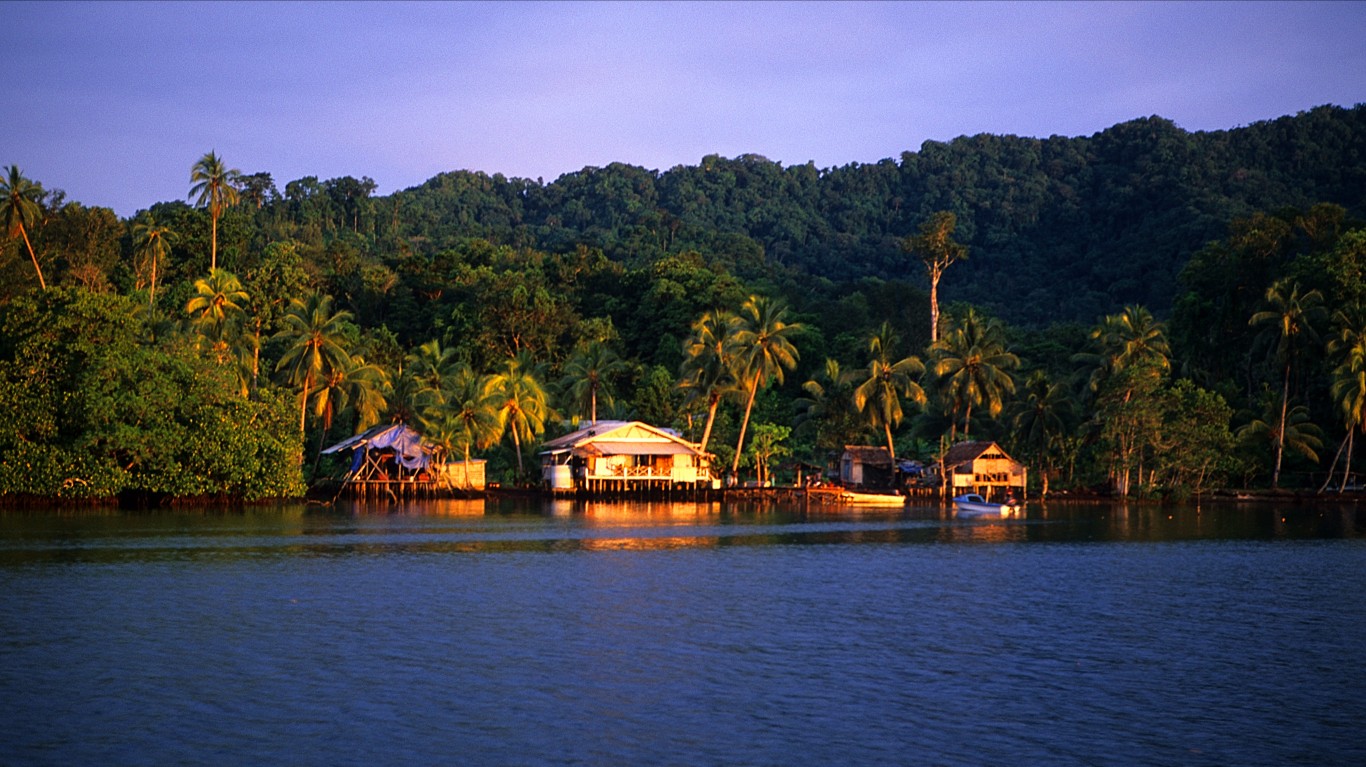
21. Solomon Islands
> GNI per capita: $2,350
> 2019 GDP: $1.4 billion (187th out of 206 countries)
> Population (2019): 669,823
> Life expectancy at birth in 2018: 72.8 years
The Solomon Islands, a nation consisting of a chain of islands east of Papua New Guinea, has one of the smallest economies in the world. The country of about 670,000 people had a GDP of just $1.4 billion 2019. Prosperity in the country has been hampered by violence and civil unrest between different ethnic groups on neighboring islands. Australia has led a peacekeeping force in the country for much of the last two decades.
Most people living in the country depend on farming and fishing. The country is heavily forested, and wood accounts for 70% of its exports. Manufactured goods are mostly imported.
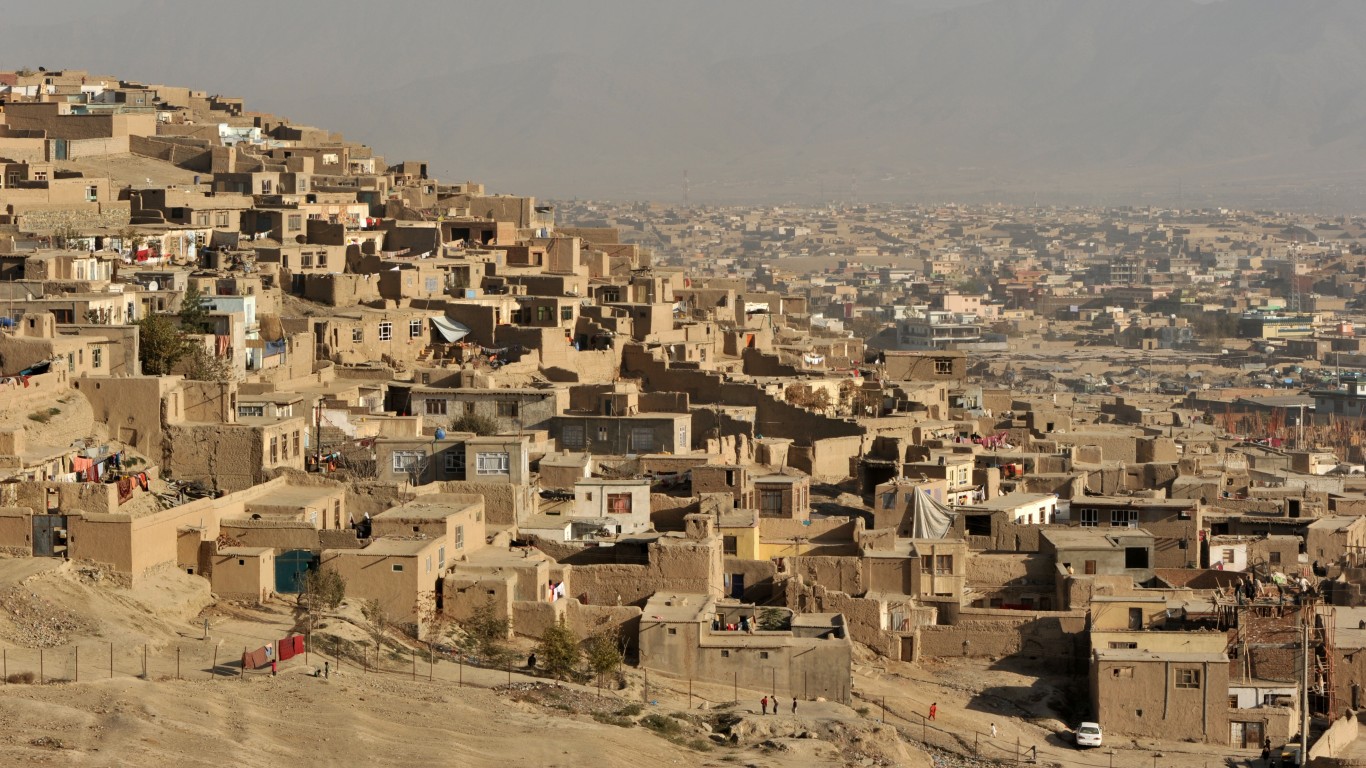
20. Afghanistan
> GNI per capita: $2,330
> 2019 GDP: $19.1 billion (115th out of 206 countries)
> Population (2019): 38.0 million
> Life expectancy at birth in 2018: 64.5 years
Instability and conflict have hampered economic development in Afghanistan in recent decades. After the Soviet Union waged war in the country from 1979 to 1989, the Taliban began to gain power in the Soviet’s absence and controlled 90% of the country by 1998. Three years later, following the 9/11 terrorist attacks, the U.S. invaded the country and still maintains a military presence there.
The country is heavily dependent on foreign aid and struggles with pervasive public sector corruption and a lack of infrastructure. Less than half of the 15 and older population is literate.
[in-text-ad]

19. Ethiopia
> GNI per capita: $2,300
> 2019 GDP: $96.1 billion (65th out of 206 countries)
> Population (2019): 112.1 million
> Life expectancy at birth in 2018: 66.2 years
The East African country of Ethiopia ranks among the poorest in the world, with a GNI per capita of just $2,300. The country has reported rapid economic growth in recent decades due to developments in the farming and services sectors as well as government investment in infrastructure. Agriculture accounts for over a third of the country’s economic output.
As is often the case in the world’s poorest countries, public health is a major challenge for Ethiopia. Life expectancy at birth is only 66.2 years, over half a decade below the global average.

18. The Gambia
> GNI per capita: $2,260
> 2019 GDP: $1.8 billion (182nd out of 206 countries)
> Population (2019): 2.3 million
> Life expectancy at birth in 2018: 61.7 years
Though it has a population of 2.3 million people, The Gambia has a GDP of $1.8 billion. It also has a GNI per capita of $2,260. The African nation had just $118 million in total exports in 2018, largely in agricultural products like nuts and fruits.
In most of the world’s poorest countries, the vast majority of the population lives in rural areas. But in The Gambia, 61.9% of the population lives in urban areas. The country is growing quickly, with its population increasing 12.6% from 2015 to 2019, well above the 4.6% population growth worldwide.

17. Rwanda
> GNI per capita: $2,240
> 2019 GDP: $10.1 billion (145th out of 206 countries)
> Population (2019): 12.6 million
> Life expectancy at birth in 2018: 68.7 years
In the mid-1990s, Rwanda was the site of one of the worst government-backed genocides in modern history, when Hutu forces killed an estimated 800,000 Tutsis and moderate Hutus. The country has struggled to rebuild its economy in recent years, exporting tea, coffee, and gold. The government has also invested more in education and infrastructure and is leveraging the service industry and building its technology industry to become a middle-income country.
Currently, however, the country ranks among the poorest in the world, with a GNI per capita of just $2,240.
[in-text-ad-2]
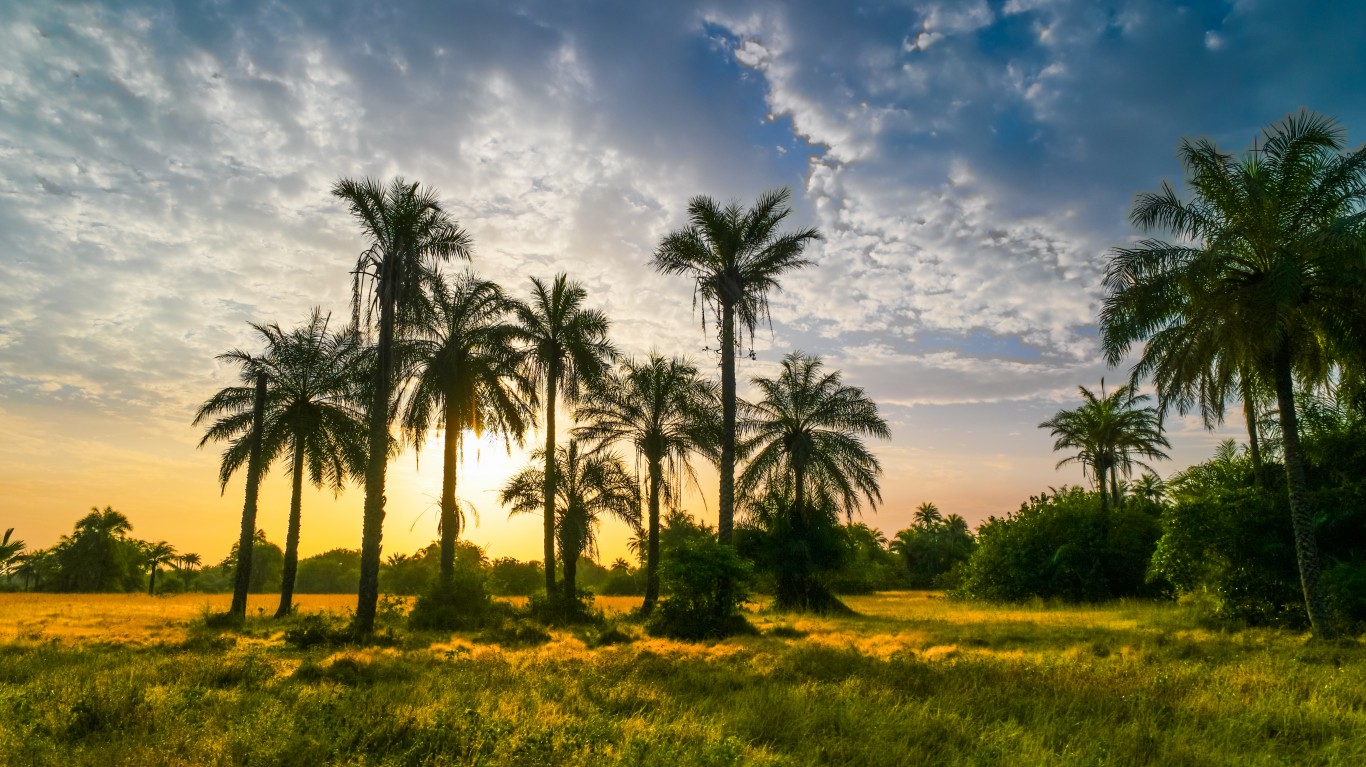
16. Guinea-Bissau
> GNI per capita: $2,220
> 2019 GDP: $1.3 billion (188th out of 206 countries)
> Population (2019): 1.9 million
> Life expectancy at birth in 2018: 58.0 years
Guinea-Bissau is a country in West Africa with a GNI per capita of just $2,220. Cashews account for the vast majority of the country’s exports, and the country depends largely on subsistence farming and foreign aid. Agriculture accounts for over half of the country’s GDP.
Economic development in the country is hampered by government corruption, and in recent years, Guinea-Bissau has become an international hub for drug trafficking.
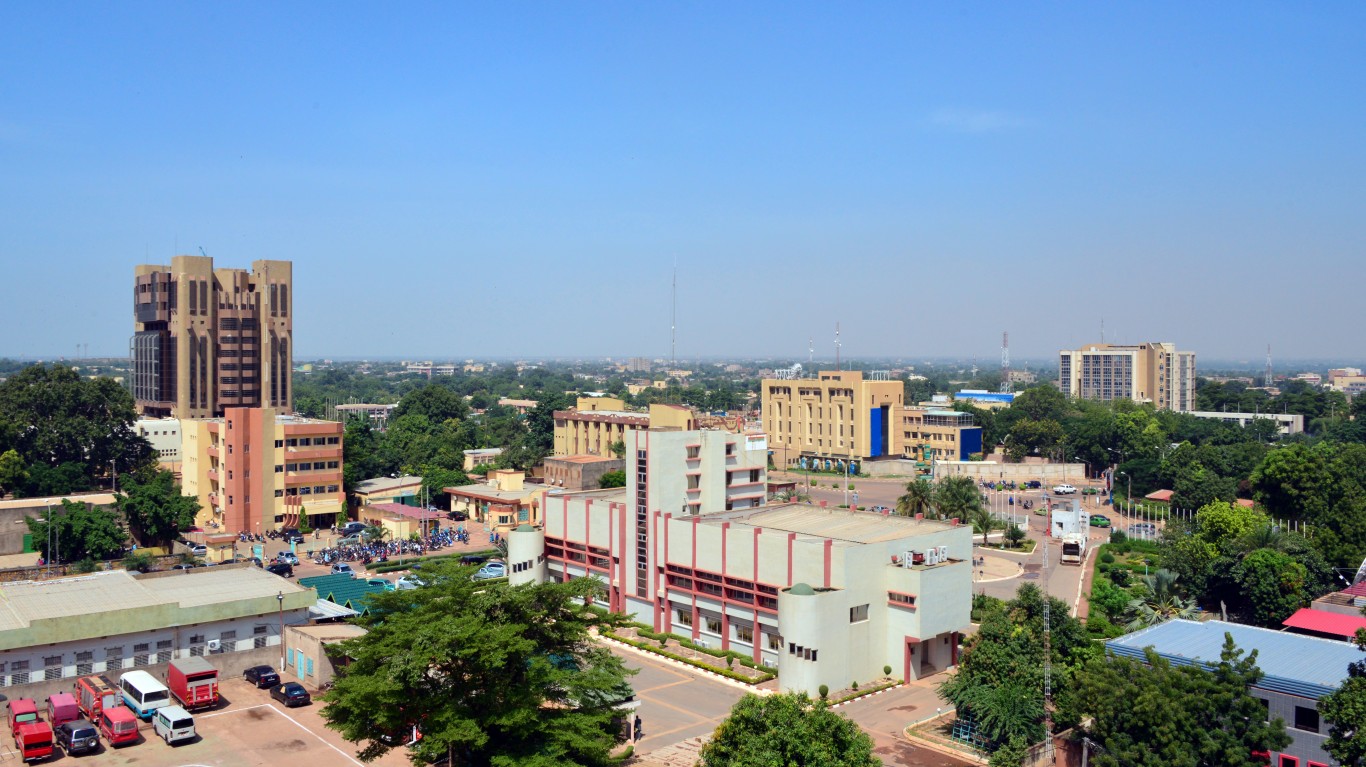
15. Burkina Faso
> GNI per capita: $2,220
> 2019 GDP: $15.7 billion (123rd out of 206 countries)
> Population (2019): 20.3 million
> Life expectancy at birth in 2018: 61.2 years
Despite having significant reserves of valuable natural resources like gold, Burkina Faso is one of the poorest countries in the world, with a GNI per capita of $2,220. Nearly 44% of the country’s 20.3 million residents live on the equivalent of $1.90 a day or less.
Economic growth in the country has been hobbled by political instability. Despite relatively poor soil quality and frequent droughts, the majority of the population relies on subsistence farming to some degree. The country’s infrastructure is lacking, as only 14.4% of the population have access to electricity.
[in-text-ad]

14. Uganda
> GNI per capita: $2,210
> 2019 GDP: $34.4 billion (99th out of 206 countries)
> Population (2019): 44.3 million
> Life expectancy at birth in 2018: 63.0 years
With a GNI per capita of $2,210, the Central African nation of Uganda is one of the least wealthy countries in the world. More than three-quarters of its population live in rural areas, and 21.9% of GDP comes from agriculture, forestry, and fishing, as compared to the 4% global average.
Like many of the poorest countries in the world, Uganda has a history of political instability and violence and is currently struggling with corruption. Rebel groups have waged violent conflicts, and many leaders have been deposed and accused of corruption in recent years.
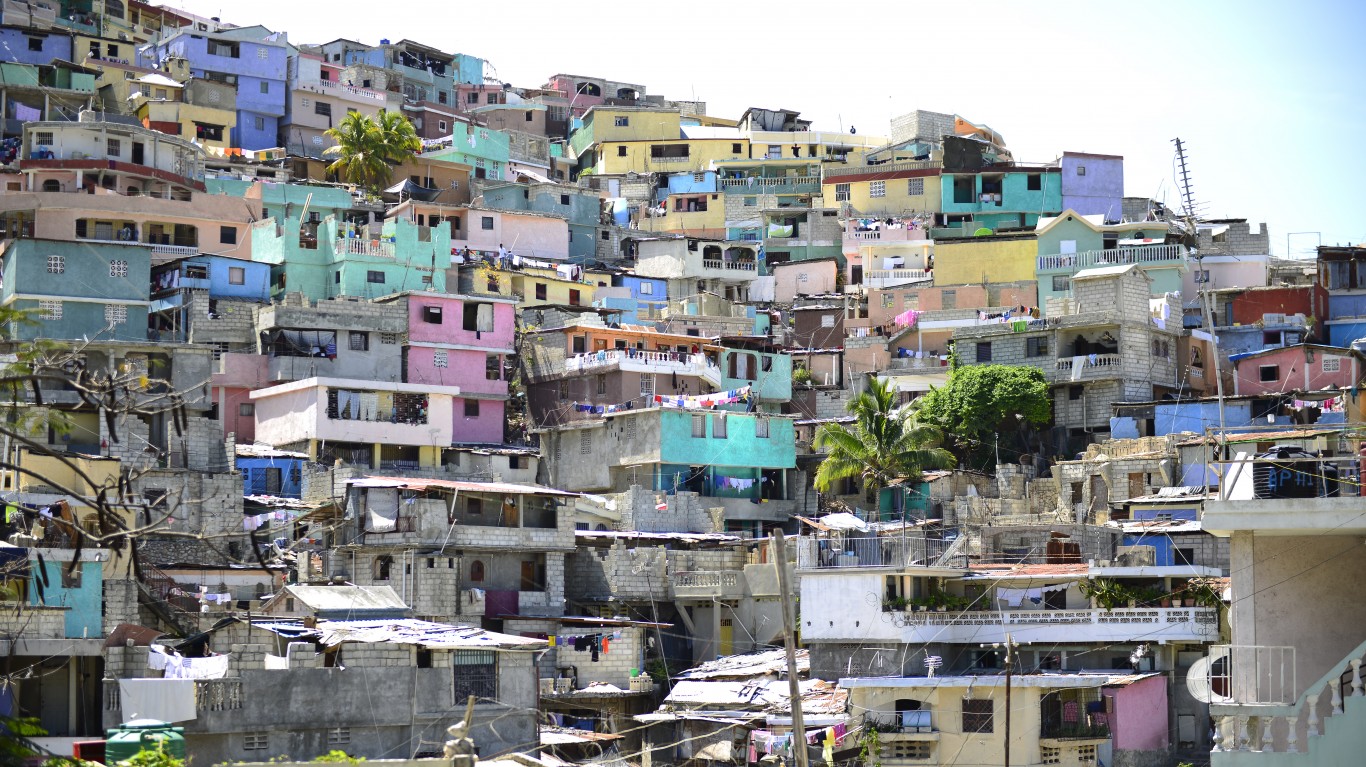
13. Haiti
> GNI per capita: $1,790
> 2019 GDP: $8.5 billion (146th out of 206 countries)
> Population (2019): 11.3 million
> Life expectancy at birth in 2018: 63.7 years
Haiti is the only North American country to rank on this list and is one of only 13 countries with a GNI per capita of less than $2,000. The country, located on the Caribbean island of Hispaniola, gained independence from France in the early 1800s and was forced to pay its former colonial master reparations for more than a century following. In more recent years, economic development has been limited by natural disasters, dictatorships, and instability.
Other hurdles the country faces include government corruption and poor infrastructure. Less than half of the country’s 11.3 million residents have access to electricity.
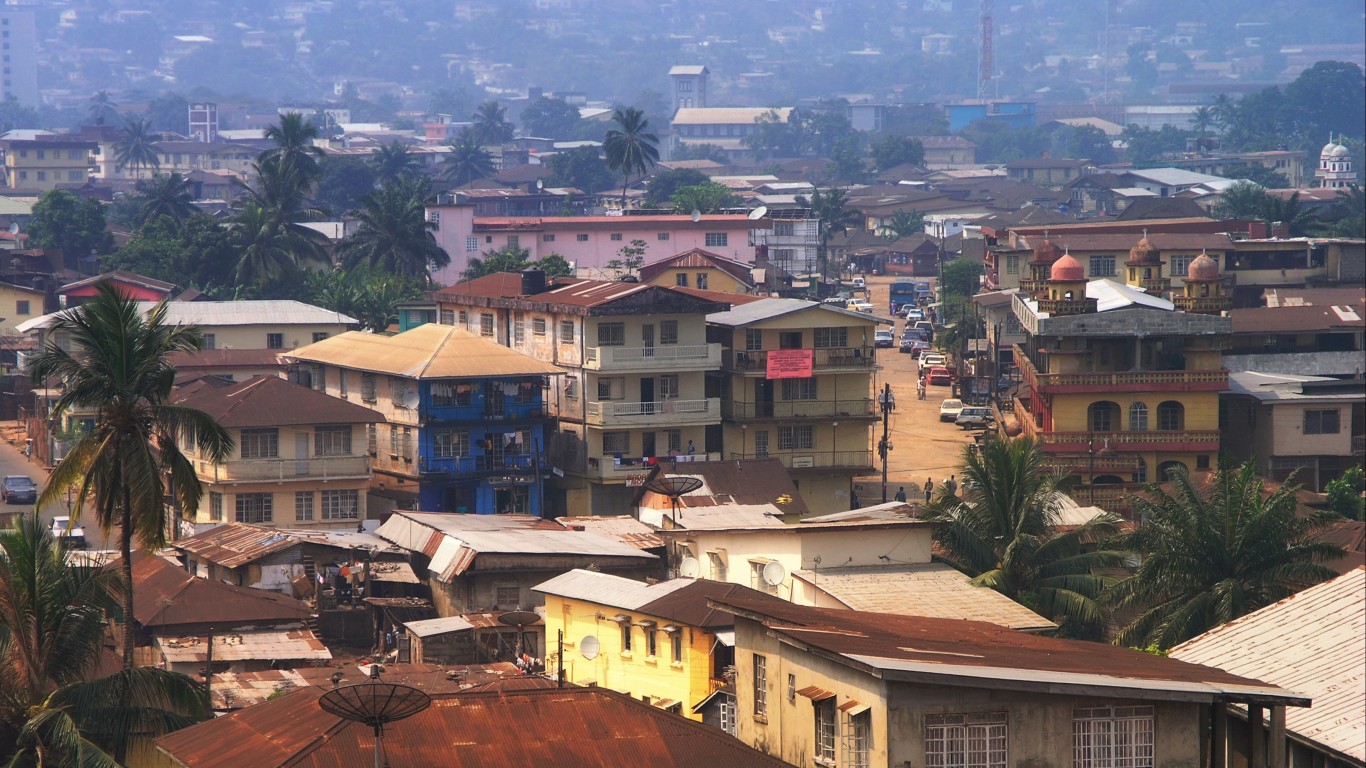
12. Sierra Leone
> GNI per capita: $1,670
> 2019 GDP: $3.9 billion (166th out of 206 countries)
> Population (2019): 7.8 million
> Life expectancy at birth in 2018: 54.3 years
Sierra Leone is a West African country that effectively had to start from scratch following a devastating civil war in the early 2000s that destroyed the country’s institutions. More recently, the country was devastated by the ebola epidemic. Though the country is rich in valuable natural resources, like diamonds, these assets have fueled violence in the country and ultimately hindered development.
As is the case in many of the world’s poorest countries, Sierra Leone depends heavily on agriculture, and public health outcomes lag behind much of the world. An estimated 57.4% of Sierra Leone’s GDP is generated by agriculture and fishing. Additionally, at just 54.3 years, life expectancy at birth in the country is nearly the lowest in the world and about 18 years below the global average.
[in-text-ad-2]
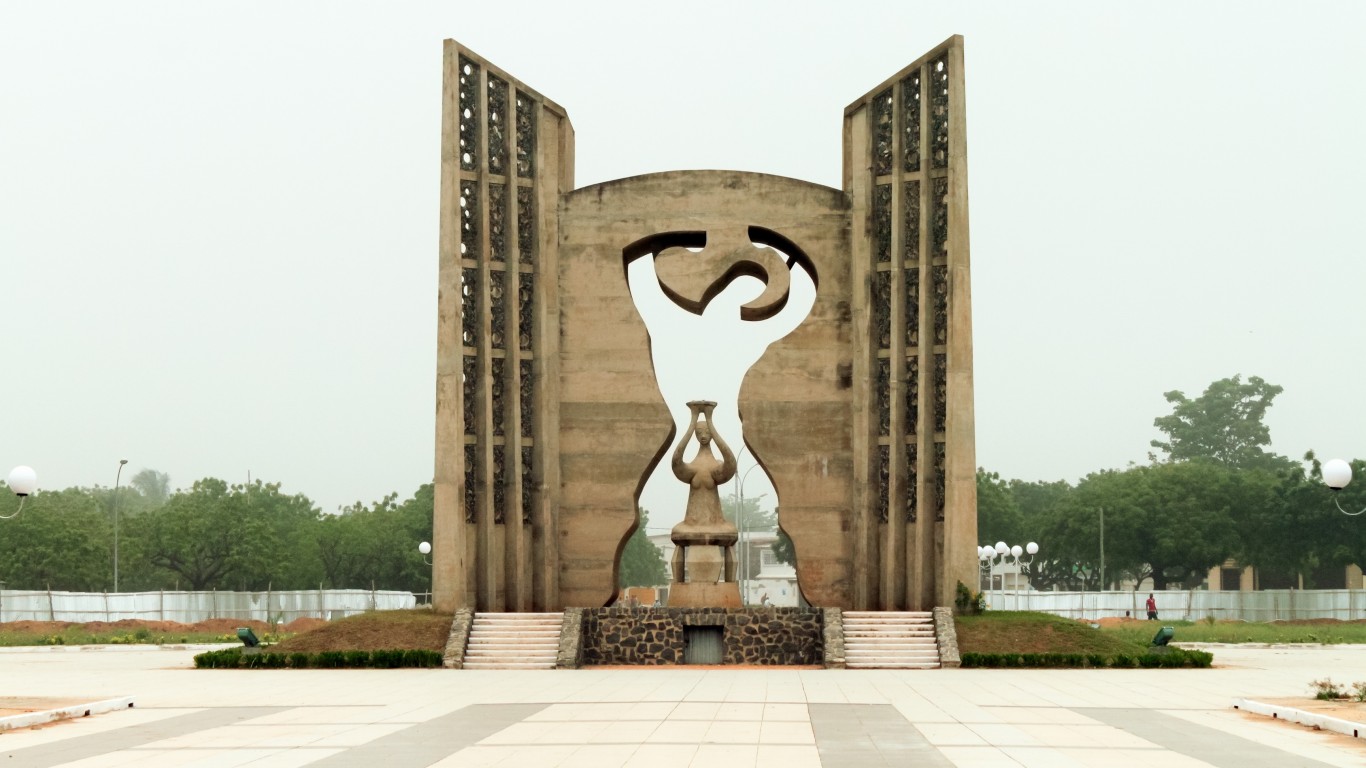
11. Togo
> GNI per capita: $1,670
> 2019 GDP: $5.5 billion (161st out of 206 countries)
> Population (2019): 8.1 million
> Life expectancy at birth in 2018: 60.8 years
Nearly half of Togo’s population lives in extreme poverty, subsisting on no more than $1.90 per day. Worldwide, 10% of people live in such poverty. The nation’s GNI per capita is one of the lowest in the world, at $1,670.
Like many other countries on this list, Togo’s economy is heavily reliant on natural resources. Petroleum accounted for over half of its $2.5 billion in exports in 2018. Togo also exported over $300 million in gold that year.
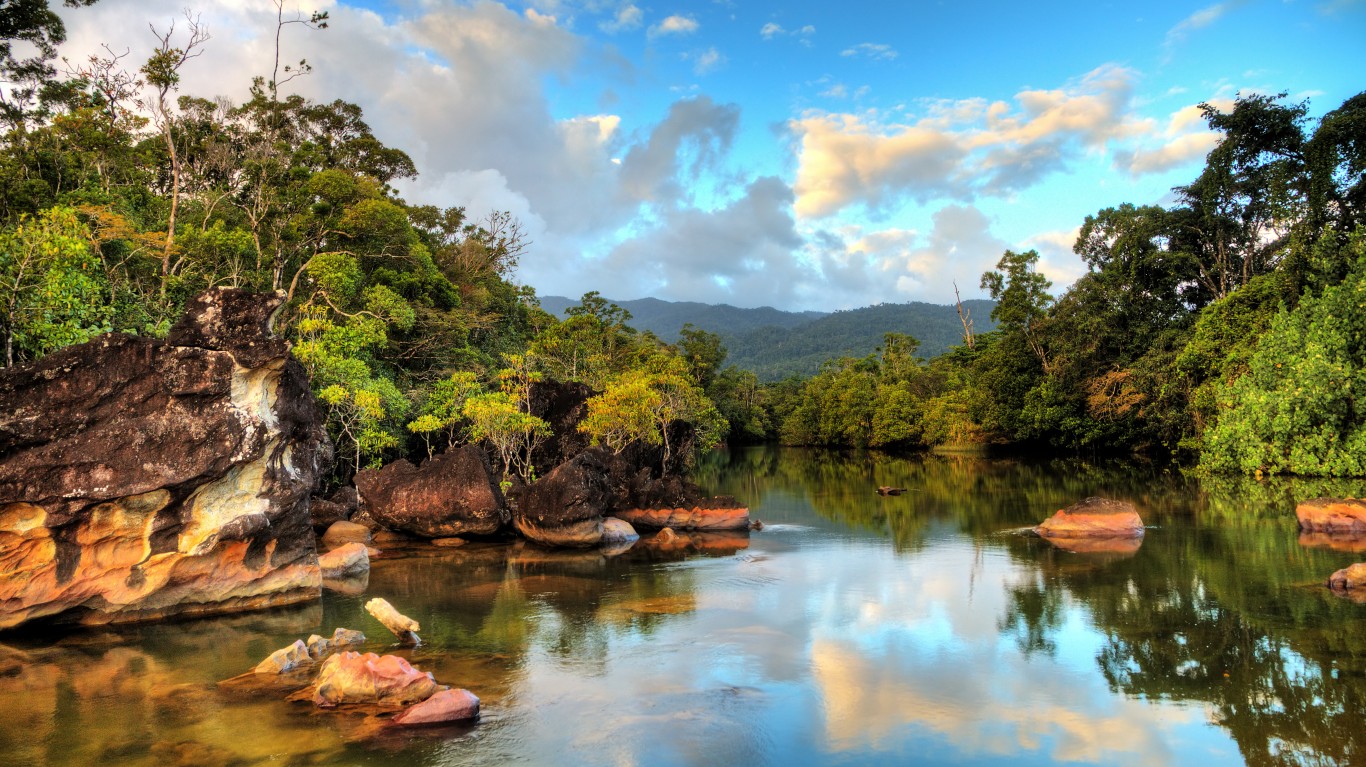
10. Madagascar
> GNI per capita: $1,660
> 2019 GDP: $14.1 billion (130th out of 206 countries)
> Population (2019): 27.0 million
> Life expectancy at birth in 2018: 66.7 years
Madagascar, an island nation off the coast of East Africa, is one of the poorest countries in the world, with a GNI per capita of $1,660. Though it exports over $1 billion of agricultural products like vanilla and cloves and has a strong tourism industry, it is dependent on foreign aid.
Development in Madagascar is held back by government corruption and lack of infrastructure. Only about one-quarter of the country’s 27 million residents have access to electricity, and 77.6% of the population lives on $1.90 or less per day.
[in-text-ad]

9. Chad
> GNI per capita: $1,620
> 2019 GDP: $11.3 billion (142nd out of 206 countries)
> Population (2019): 15.9 million
> Life expectancy at birth in 2018: 54.0 years
Chad’s $11.3 billion economy is smaller than that of some countries home to far fewer people. It has the ninth lowest GNIs per capita, at $1,620.
Poorer countries often face significant health challenges related to poverty and lacking health care systems among other factors. Chad’s life expectancy at birth is just 54 years — nearly two decades less than the global average and the third lowest of any country on Earth. The country also has the fifth highest infant mortality rate of any country, at 71.4 deaths per 1,000 live births.

8. Liberia
> GNI per capita: $1,320
> 2019 GDP: $3.1 billion (171st out of 206 countries)
> Population (2019): 4.9 million
> Life expectancy at birth in 2018: 63.7 years
The West African nation of Liberia, founded by freed American slaves, is one of the poorest countries in the world. Liberia has a GNI per capita of $1,320, and 40.9% of the population lives on $1.90 or less per day. Like many poor countries, Liberia is heavily dependent on farming. The agriculture, fishing, and forestry sector accounts for 39% of the country’s GDP, compared to the global average of about 4%.
Less than half the country’s 15 and older residents are literate, and only about a quarter of the total population has access to electricity. Government corruption is also a barrier to Liberia’s development.
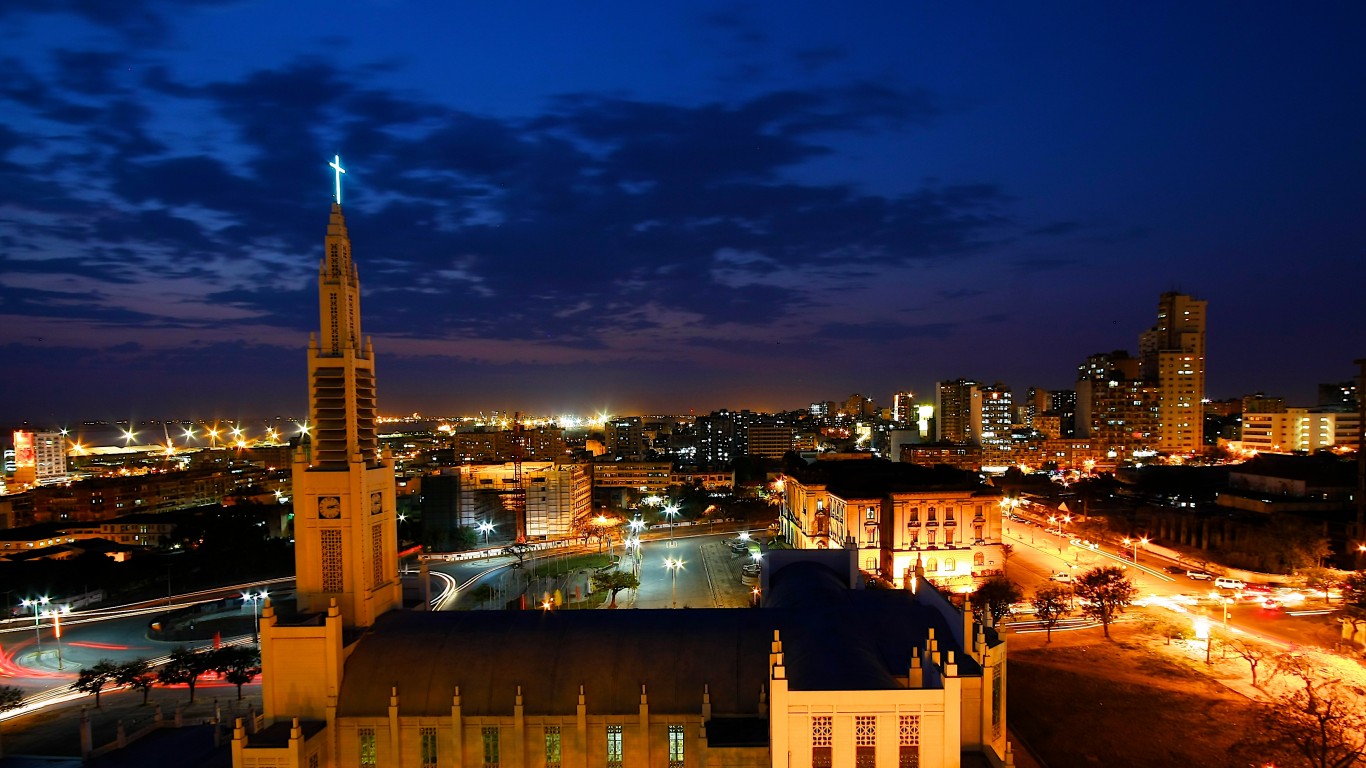
7. Mozambique
> GNI per capita: $1,300
> 2019 GDP: $14.9 billion (125th out of 206 countries)
> Population (2019): 30.4 million
> Life expectancy at birth in 2018: 60.2 years
Mozambique is one of just seven nations with a GNI per capita of $1,300 or lower. It has the fifth highest extreme poverty rate of any nation, as 62.9% of its population lives on $1.90 per day or less.
Mozambique residents are more likely to face significant health challenges than those in almost every other country. More than one in eight residents ages 15 to 49 have been diagnosed with HIV, as compared to 0.8% of people worldwide. Mozambique’s incidence of tuberculosis is 551 per 100,000 people, more than four times the global concentration of the disease.
[in-text-ad-2]
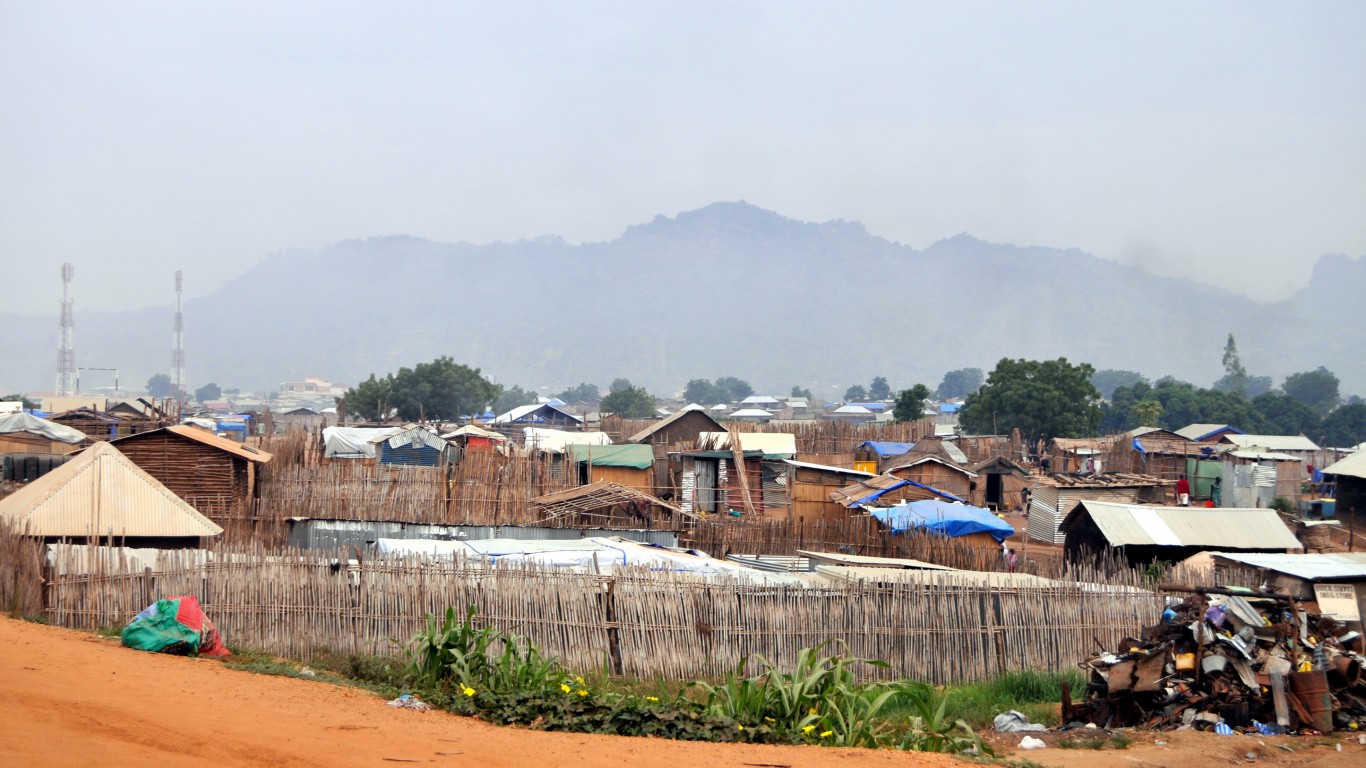
6. South Sudan
> GNI per capita: $1,280
> 2015 GDP: $12.0 billion (140th out of 206 countries)
> Population (2019): 11.1 million
> Life expectancy at birth in 2018: 57.6 years
South Sudan was formed in 2011, gaining independence from Sudan as part of a peace deal that ended Africa’s longest-running civil war. Yet for most of the country’s existence to date it has suffered from its own devastating civil war. Infrastructure is lacking in the country as only about 2% of the roadway is paved, and only 28% of the population has access to electricity.
South Sudan is also one of the most corrupt countries in the world. Though the country is rich in natural resources like oil, water, and fertile soil, the vast majority of goods in the country are imported. South Sudan’s GNI per capita is just $1,280.

5. Niger
> GNI per capita: $1,250
> 2019 GDP: $12.9 billion (135th out of 206 countries)
> Population (2019): 23.3 million
> Life expectancy at birth in 2018: 62.0 years
Niger exported just $539 million of goods in 2018, less than the vast majority of other countries. Gold accounted for over $300 million worth of these exports, with much of the rest coming from agricultural products.
More than 83% of Niger’s population lives in rural areas, and its economy is more reliant on agriculture than almost any other nation’s is — 38.2% of its GDP comes from agriculture, forestry, or fishing. Niger’s GNI per capita is one of the lowest in the world, at $1,250.
[in-text-ad]

4. Democratic Republic of the Congo
> GNI per capita: $1,110
> 2019 GDP: $47.3 billion (91st out of 206 countries)
> Population (2019): 86.8 million
> Life expectancy at birth in 2018: 60.4 years
Like many other countries on this list, the Democratic Republic of the Congo is rich in valuable mineral resources. Rather than being an economic boon, however, control of these resources has fueled violence and a civil war that has resulted in millions of deaths and government corruption.
The country ranks among the poorest in the world with a GNI per capita of just $1,110. More than three-quarters of the country’s 86.8 million residents live on $1.90 or less per day, below the poverty line set by the World Bank.

3. Malawi
> GNI per capita: $1,080
> 2019 GDP: $7.7 billion (150th out of 206 countries)
> Population (2019): 18.6 million
> Life expectancy at birth in 2018: 63.8 years
Malawi’s GNI per capita of $1,080 is a fraction of the worldwide GNI per capita of $17,591. More than 70% of the nation’s residents live on $1.90 per day or less, as compared to 10% of the world’s population overall.
Malawi is a largely rural country with an economy that relies on agriculture. Nearly 83% of the country lives in rural areas, and tobacco accounts for more than two-thirds of its total annual export value.
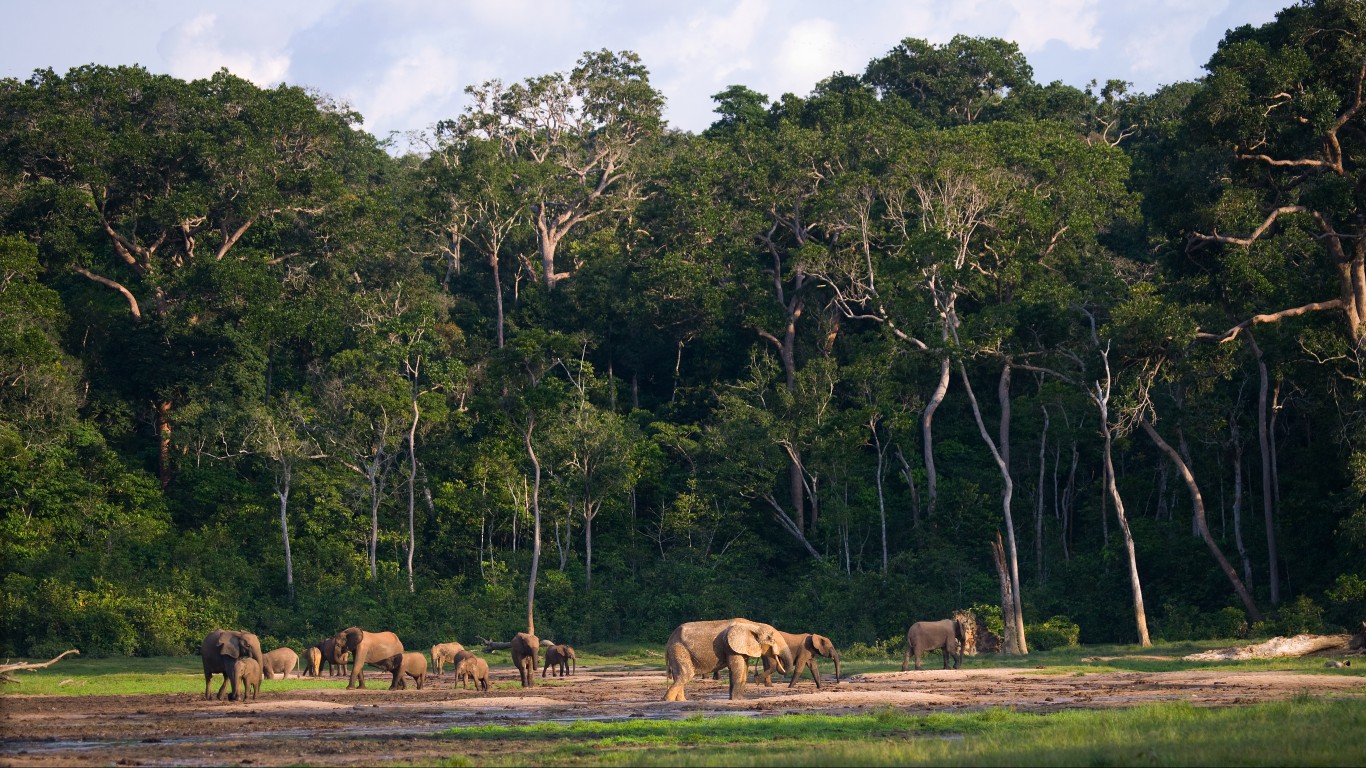
2. Central African Republic
> GNI per capita: $1,060
> 2019 GDP: $2.2 billion (178th out of 206 countries)
> Population (2019): 4.7 million
> Life expectancy at birth in 2018: 52.8 years
The Central African Republic has the second lowest GNI per capita, at just over $1,000. It exported less than $100 million worth of goods in 2018 — which accounts for a very small share of its GDP — over 70% of which was wood.
Like many other impoverished nations, the Central African Republic has among the worst health outcomes in the world. It has the lowest life expectancy at birth of any country at 52.8 years — nearly two decades lower than the worldwide average life expectancy. It also has the highest infant mortality rate, at 84.5 deaths per 1,000 live births.
[in-text-ad-2]
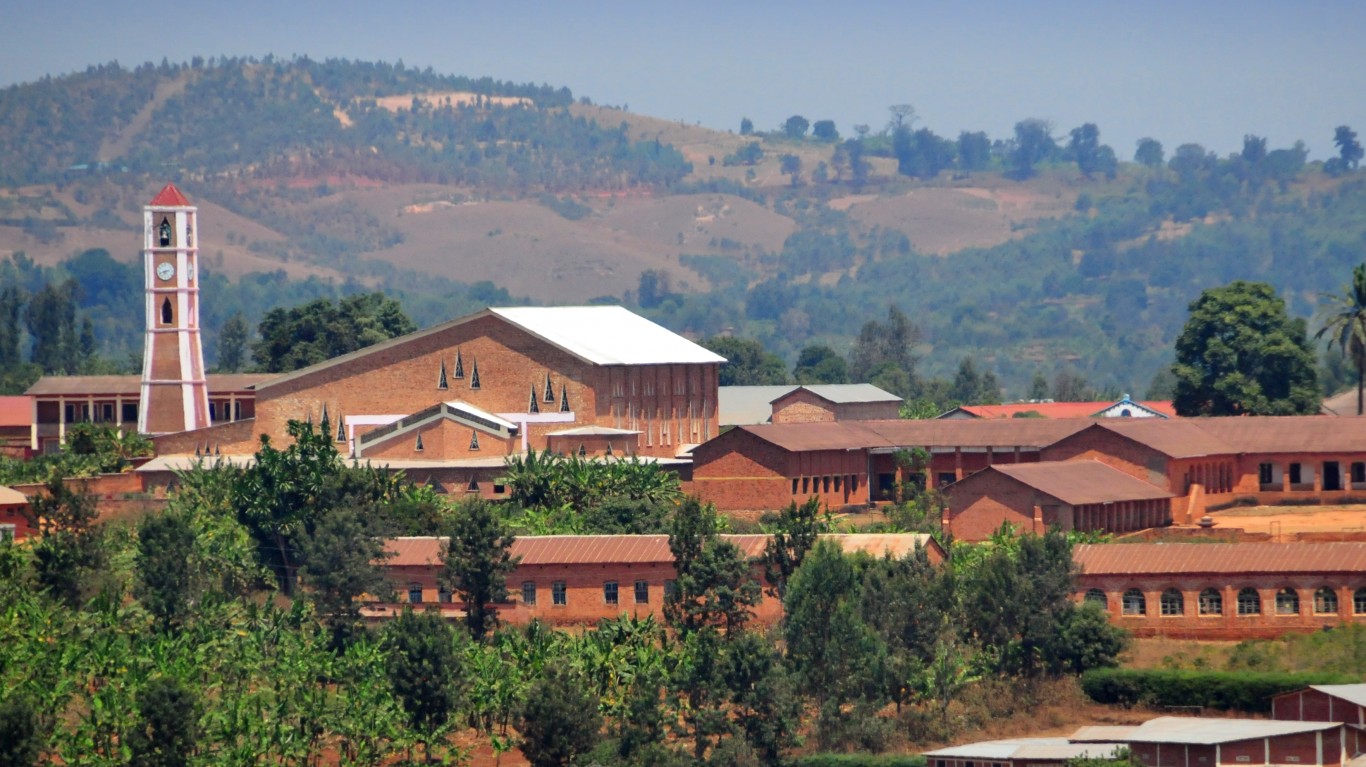
1. Burundi
> GNI per capita: $780
> 2019 GDP: $3.0 billion (174th out of 206 countries)
> Population (2019): 11.5 million
> Life expectancy at birth in 2018: 61.2 years
Burundi is the poorest country in the world by a wide margin. Its gross national income per capita is just $780, as compared to a worldwide GNI per capita of $17,591. It is the only country with a GNI per capita below $1,000. More than 70% of its population lives on $1.90 per day or less — over 8 million total people.
Like many other countries that rank among the world’s poorest, the majority or Burundi’s residents live outside urban areas — 86.6% reside in rural areas, the second highest share of any country and nearly double the worldwide share. The country had just $272 million in exports in 2018, far less than most other countries, 41.5% of which was in gold.
Methodology:
To determine the poorest countries in the world, 24/7 Wall St. reviewed data on GNI per capita for 194 countries and special regions with available data from the World Bank. The World Bank estimates GNI per capita using the purchasing power parity method, and figures are in current international dollars. All data on GNI per capita is based on the most recent available year for a given country.
Additional data, measuring GDP in current U.S. dollars, population, life expectancy at birth, and access to electricity also came from the World Bank. All data are for the most recent year available for every country.
We also considered data on levels of public sector corruption from the nonprofit, international watchdog and anti-corruption group, Transparency International.
In 20 Years, I Haven’t Seen A Cash Back Card This Good
After two decades of reviewing financial products I haven’t seen anything like this. Credit card companies are at war, handing out free rewards and benefits to win the best customers.
A good cash back card can be worth thousands of dollars a year in free money, not to mention other perks like travel, insurance, and access to fancy lounges.
Our top pick today pays up to 5% cash back, a $200 bonus on top, and $0 annual fee. Click here to apply before they stop offering rewards this generous.
Flywheel Publishing has partnered with CardRatings for our coverage of credit card products. Flywheel Publishing and CardRatings may receive a commission from card issuers.
Thank you for reading! Have some feedback for us?
Contact the 24/7 Wall St. editorial team.
 24/7 Wall St.
24/7 Wall St. 24/7 Wall St.
24/7 Wall St. 24/7 Wall St.
24/7 Wall St. 24/7 Wall St.
24/7 Wall St.

